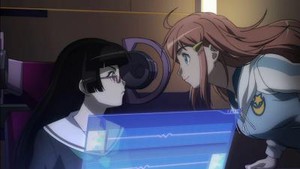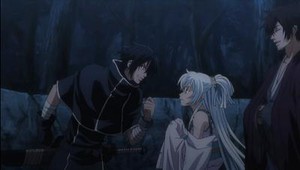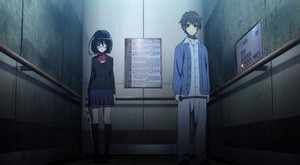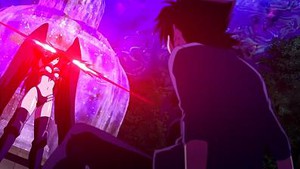The Winter 2012 Anime Preview Guide
Theron Martin

Another episode 2
Rating: 3 (of 5)
Review: As Kouichi goes about his regular school business, he has a couple more brief conversations with Mei, gets invited to join the art club, and has talks with fellow students about various things. Some seem like they want to talk to him about something specific, but others keep interfering. One girl declares herself to be in charge of class “countermeasures,” but she is prevented from explaining that and naturally Kouichi isn't suspicious enough to press for an explanation. The only one who will talk frankly to him is a nurse at the hospital, who is willing to help him find out about whether or not Mei had a legitimate reason for visiting the morgue the night that Kouichi met her in the hospital. Kouichi also gets distracted by following Mei around, which leads him to a creepy doll store where he meets Mei and she promises to show him what's under her eye patch.
If you're expecting to get the answer to the latter in this episode then you're going to be disappointed, as it ends on that “cliffhanger.” Even so, it and the bit with the nurse represent all that the series has been willing to tell us this far about what's going on, and both that and Koichi's seeming cluelessness is getting irritating. Even if Kouichi doesn't know that he's in the middle of a horror story, he is still a fan of horror novels (he likes John Saul) and so should be picking up on all of the red flags going up around him. The viewer certainly can't fail to miss all of the signs, as the production lays the dark atmosphere on thick as can be, complete with continuing random doll shots, the overactive musical score, and discussion about Munch's famous painting The Scream and how it reflects the anxiety of the world.
This one still gets a middling grade from me because its production values are high and it is trying really hard to do what it's supposed to do; the doll shop scene in particular is well-executed. Eventually, though, it needs to stop stringing viewers along and produce something of substance.
Another is currently streaming on Crunchyroll.

Lagrange Episode 2
Rating: 2.5 (of 5)
Review: In one late scene in episode 2, heroine Madoka is sitting inside her bonded alien mecha, called the Vox Aura, which is drifting underwater after having gone inactive during a fight. So what does she do? Carry on a cell phone conversation with the older cousin who didn't want her to get wrapped up in this business in the first place, one which is listened in on by nearly everyone at the nearby HQ.
Well, that, at least, is an amusing twist. Nothing much else is in this second episode, however. Spunky Madoka is still the biggest draw as the normally self-confident Jill of All Trades, and starting with this episode gets a sleek battle outfit (seen in the picture) to wear, too, while Lan remains just barely interesting as the alien girl (and she's suggested to be one of some standing) who deeply regrets getting Madoka involve din all of this. A ditzy, big-breasted girl who is apparently intended to be another pilot also briefly wanders into the picture, but mostly the episode is about the pretty boy alien bad guys coming down to investigate what happened to their compatriot and Madoka quickly getting pressed into duty once again - something that the fleet commander is very leery about but has no choice, since conventional weaponry can't do much against the enemy Ovids.
Lagrange might be a passable mecha series in another season, but it has the misfortune do be debuting in the same season as two series who execute different aspects of it far better. Aquarion Evol, for as silly as it is, blows Lagrange away when it comes to CG mecha battles and Bodacious Space Pirates does the developing heroine better. Lagrange is more straightforward and gets into the action more quickly, so those who find the former too slow to develop might find the pacing of this one more to their liking, but this is also a far more generic story and shows far less overall potential. Both outshine this one on the technical front, too. Still, this episode is a minor improvement from the first one.
Lagrange is currently streaming at VizAnime.

Bodacious Space Pirates episode 2
Rating: 5 (of 5)
Review: I gave the first episode a 4.5 rating based on the load of potential it showed. I am upping my grade to the max for this episode because I simply cannot imagine this concept being done any better at this stage than what this series is doing it.
Given how the first episode went, the second does not play out as one would expect. Marika's flight from the diner does not take her directly to the Bentenmaru; only to a safe distance, where Chiaki explains a few things to her. Later, Marika has a talk with her mother about her situation, which leads to a trip out to an old ship graveyard for her first taste of target practice. A short time later Kane, who has become the Yacht Club's new advisor, arranges a practice voyage aboard the club's full-size ship Odette II, which Kane secretly recognizes as a made-over version of one of the Bentenmaru's sister ships amongst the original seven great pirate ships. While preparing for launch, Marika and Chiaki get a bit of a taste of electronic warfare as someone seems intent on infiltrating the Odette II's systems.
Episode 2 is wonderful as much for what it doesn't do as for what it does. It has, so far, resisted all but one extremely brief attempt at fan service (and that involved an adult), and fan service would feel out of place here anyway. Most importantly, though, it does not shoehorn Marika into her destined position just to get the action started. Based on the pacing here and what's shown in the Next Episode preview, this series could be as much about Marika becoming the captain of the Bentenmaru as actually being the captain - and that makes this series special, because we get to see Marika grow into the role in a sensible fashion. This episode is very much about her learning what it may mean to be a privateer ship captain, from dealing with electronic warfare to understanding the power and importance that holding a gun can hold. Marika also continues to show that she is a great character, a young woman who has the decisiveness needed in a crisis and the caution necessary to make a reasoned decision. Chiaki complements her nicely, and the scene showing her still holding her parfait even after having fled the café with Marika is a neat touch. Satelight's artistry and animation are also still above-average; the musical has not impressed as much but that's only a minor flaw.
This one isn't just a strong entry in its genre; it has the very real potential to be one of the year's best overall series if the quality level seen in these first two episodes holds. It is certainly my initial choice for the all-around best new series this season.
Bodacious Space Pirates is currently streaming on Crunchyroll.

The Knight in the Area episode 2
Rating: 2 (of 5)
Review: After getting shanghaied into playing in a selection match by elder brother Suguru, Kakeru quickly proves to the trained eye that he's the only one on offense who can keep up with Suguru's “serious” passes. There's just one problem: he didn't earn the nickname “No Goal Kakeru” for nothing and seems especially reluctant to fully use his left foot, so even once he can take Suguru's passes, he can't score. Suguru labels it a lack of heart, an accusation which Kakeru can't deny. After a blow-up with Suguru at home and another one-on-one match with the alien masked player to clear his head, Kakeru comes to a fateful decision. Just as he and his brother are discussing it, though, tragedy strikes.
In an effort to cover all the necessary content and reach its cliffhanger, this episode takes the extremely rare move of actually entirely skipping both the closer and end credits. Concentrating on a more graceful set-up might have been a better idea, though, as this episode is entirely too transparent in what it's doing and its attempts to foreshadow give away too much. We do find out that Kakeru's mysterious problem with his left foot is psychological and, while it isn't entirely implausible, it certainly seems gimmicky. Despite the episode's valiant attempts, it lacks the quality Kakeru is accused of lacking - competitive heart - as well as subtlety. Even nearly half an episode of concentration on actual soccer action does not redeem that, in part because the animation is simply not good enough to make it dynamic. A lame musical score doesn't help, either. At least this episode does explain the series’ name.
Maybe I'm not “getting“ this because I have no interest whatsoever in soccer, but series like Cross Game showed that sports series can overcome that if the rest of their writing is good enough. This one is not anywhere near on that same level.
The Knight in the Area is currently streaming on Crunchyroll.

Ino x Boku SS
Rating: 3.5 (of 5)
Review: Ririchiyo, scion of the powerful Shirakiin family, is moving into the Maison de Ayakashi apartment complex ostensibly because it's a security-conscious establishment restricted to the elite, one where each resident has his or her own personal Secret Service attendant/bodyguard. In actuality she's doing it to isolate herself because she is painfully aware of her nasty habit of taking an uppity attitude with everyone around her in order to mask her social awkwardness. Though she had not planned on it, she discovers on arrival that someone has appointed a Secret Service agent for her - in this case Soushi, a handsome man with mismatched eyes who openly declares that he wants to be her “dog” and asks her to kill him when she won't accept his servitude, as he has no other reason to live. As two robbers who sneak onto the premises eventually discover, there is another reason why Ririchiyo moved there: it is also a haven for half-monsters (and both she and Soushi are ones), and they don't take kindly to human interlopers.
This first episode does not cleanly fall into a single genre; in fact, it seems to be attempting a delicate balancing act in order to maximize its potential audience. Certain design and plot elements have unmistakable shojo romance style points, yet a couple of provocative shots of Ririchiyo and one lesbian character are clearly aimed at guys. It is primarily composed of light-hearted and silly content (including a fair amount of SD), yet Ririchiyo is being seriously introspective throughout. It features people who can turn into monsters (though we don't get to see what Ririchiyo really is in this episode), but that seems like more of a sidelight to Ririchiyo's struggles with herself. Unlike many other series that try to be all things to everyone, though, this one might actually work. That Ririchyo is, essentially, a self-aware tsundere and doesn't like being one is an interesting twist; the self-exploration and character development potential here is great, and the writing actually does a respectable job of balancing it with the lighter elements. Doubtless this will head in a direction where Soushi helps Ririchiyo overcome her troubles, but that could be interesting too.
The technical merits and sound are nothing special, but this one isn't aiming to dazzle viewers that way. Surprisingly, Ririchiyo is not voiced by Rie Kugimiya, although her actual seiyuu - up-and-comer Rina Hidaka - certainly sounds like her. (Or perhaps that's just the accepted sound for tsunderes?) Overall, this first episode probably most resembles the beginning of Toradora!: a bit beyond the norm with the potential for much more.
Inu x Boku SS is currently streaming on Crunchyroll.

Ano Nattsu de Matteru
Rating: 3.5 (of 5)
Review: While high school camera buff Kaito was checking out his new recorder one night, something impacted nearby and grievously harmed him, but he has only vague recollections of a woman's hand reaching out to him and wakes up the next morning as if nothing had happened. At school that day, while tossing around ideas for a summer activity with friends, he learns that a new transfer student has arrived – Ichika Takatsuki, a girl who stands out for her red hair and busty figure – and finds himself strangely drawn to her (even beyond her being hot). His ladies’ man friend invites Ichika to join them on an as-yet-undecided movie project, and to everyone's surprise she eagerly agrees. Kaito's fantasy about Ichika coming to live with him during his elder sister's upcoming overseas trip (what is it with elder sisters raising younger male siblings this season?) also strangely becomes true, but the full truth is stranger still, for Ichika is apparently not from this world.
The premise for this series, the latest in a line of “alien must heal Earthling boy accidentally hurt/killed by the alien's arrival” sci fi tales, reads an awful lot like a harem romantic comedy, and indeed Kaito does seem to have a wide variety of girls in his orbit. This one never gives the expected feel of a typical harem series, though. Despite an occasional mild joke, its tone is quite a bit more serious, and the only notable fan service moment happens while Kaito is already unconscious due to an apparent flaw in the alien tech used to restore him. One does not normally see harem series narrated by the main character like this one is, either. Could this actually be the rare series which tries to strike a sensible balance between slice-of-life stories and sci fi romances? The musical score is also low-key, and the background art almost photorealistic at times, though the character designs are not as sharp. Significantly, Kaito does not fit the normal physical mode for a harem lead, either.
The predictably awkward situation at the end of the episode doesn't change the fact that this one holds more promise the most series of its type. Even those who wouldn't normally touch the genre might want to give this one a chance.
Ano Natsu de Matteru is currently streaming at Crunchyroll.

Daily Lives of High School Boys
Rating: 5 (of 5)
Review: If an episode of any anime series has come out in the last couple of years which has more big laughs than this one has, I have not seen it.
And yes, I know how bold a statement that is, but slice-of-life comedies built on short sketches simply do not come funnier than this one. The premise is very, very basic: three friends - Tadakuni, Yoshitake, and Hidenori - all attend the same all-boys high school. In their spare time they hang out with each other and screw around, often in very juvenile ways.
And that's it. Beyond that is just a succession of skits typically 3-4 minutes in length involving boys messing around in very boyish ways, but oh, the ways they do that! Some ideas are lewd (without actually getting involved in fan service), others are crude (without being too vulgar), and still others are just plain silly, but many of them are fresh gags, or fresh spins on old gags, which feel exactly like the kind of shenanigans that bored teen boys might get into and all are enormously funny. Arguably the best involves a round of supposed horror stories that goes unimaginably awry, but everyone will find a favorite, whether it be in the core jokes or simple parodies like an ingenious early rip on the classic scene of a student who's running late with a piece of toast hanging out of his/her mouth. The closer gets in on the game, too, and even the “sponsored by” bars (one of which tells viewers that they don't need to remember the characters’ names) aren't immune.
The technical merits give the artistry a muted, washed-out look but are plenty good enough to promote all of the jokes. This isn't a series you'll be watching for the way it looks, though. This is one to watch for the way it makes you laugh, and it does a damn good job at that.

Brave 10
Rating: 3 (of 5)
Review: In turn-of-the-17th-century Japan, pretty priestess Isanami must flee a massacre at her temple perpetrated by a mysterious ninja. In her flight she runs across Saizo Kikagure, a masterless Iga ninja, and begs him for help. Saizo is disinclined at first, but attacking ninja who seek to eliminate both Isanami and anyone who might be a witness leave him little choice. Afterwards, Isanami cajoles Saizo into escorting her to the castle of Sanada Yukimura, a lord recommended to her by her master. After using an initial refusal to bait a trap to draw out what he might be dealing with, Sanada agrees to help, especially after seeing the potentially devastating power that Isanami possesses. To obtain his goals Sanada must gather ten brave warriors, and the suspicious Saizo is to be one of them. If only Isanami wasn't such a handful to deal with. . .
So goes this season's obligatory late Warring States-era period piece, which this time seems intent on focusing on the Sanada Ten Braves of Japanese folklore, warriors in service to Sanada Yukimura who have appeared, in some form or another, in multiple other anime set in the same time period but have not, to my knowledge, previously been featured. Like other period pieces, this one heavily involves super-powered samurai and ninja tossing powers and attacks around, although this one's fight animation and choreography are better than most. Isanami provides an atypical anchoring point, though: she's just flaky enough to prevent everything from being taken too seriously, but her story, situation, and power are dark enough to prevent the story from being taken too lightly. One very sexy scene involving her towards the end of the episode, which is borrowed directly from a harem romantic comedy playbook, feels out of place, however.
While the story has yet to do anything special so far - even with Isanami at the center of things, this is a pretty typical samurai/ninja tale - the technical merits carry it for now. Relatively new Studio Sakimakura, whose only other production effort is Cardfight!! Vanguard, produces a nice-looking and nicely-animated first episode which includes sharp character designs (even if Isanami looks like she stepped out of Full Metal Panic!) and great battle scenes. The first episode is worth checking out for those alone.
Brave 10 is currently streaming on Crunchyroll.

Listen to Me Girls, I'm Your Father
Rating: 2.5 (of 5)
Review: 19 year old Yuuta is a newly-minted college student. Upon joining the rather odd Sightseeing Club he makes the acquaintance of Raika, an even odder but nonetheless pretty and curvaceous upperclasswoman, and starts to fall for her (despite warnings that the guys who used to flock around her are now staying away), and she doesn't seem to mind his company. Things are looking up for Yuuta, but his life is about to get much more complicated: his older sister, who essentially raised him, has just shanghaied him into looking after her three daughters (a young one with her husband, two older ones from his previous marriages) while she and her hubby are away on some kind of lengthy trip. And the eldest, a middle schooler, has a crush on him, too. . .
This production, which is based on a light novel series, comes from the director of Rental Magica and the same studio (Feel) which produced Kiss x sis. The latter fact will doubtlessly stoke suspicions raised by the premise that this will be another abysmally trashy show which flirts around incest on technicalities, and indeed, a couple of scenes in the late stages of this one (including the predictable one where Yuuta walks in on the crushing Sora while she's getting dressed) feed into that impression. The older sister snookering Yuuta into this duty also seems like the kind of awkward contrivance often used to set up a premise in an ero game.
For all of the negative signs, though, the first episode also offers some evident hope that it might aim at least a little higher. All of the sisters have shown reasonable and realistic personalities so far, especially Hina, who is one of the most credible 3-year-olds you're likely to see in anime. An occasional line implies a serious undertone, the premise leaves room for engaging in some genuine exploration of family dynamics, and the fan service and tone feel surprisingly restrained compared to more all-out-nasty series.
There's still every possibility that this one could, indeed, prove to be what people think it is, but don't completely write it off yet,
Listen to Me Girls, I'm Your Father is currently streaming on Crunchyroll.

Another
Rating: 3 (of 5)
Review: In 1998, 9th grader Kouichi Sakakibara's transfer to Yomi North in a country town is delayed for a few weeks when he is hospitalized for a collapsed lung. There he meets representatives of Class 9-3, his new class, who behave a bit oddly as they pester him about whether or not he's ever lived in the area before. He later meets an eyepatch-wearing girl (and what is this weird anime fetish about girls wearing eye patches, anyway?) in a hospital elevator who seems to be headed to the morgue carrying a white doll and admits to being Mei Misaki. When Kouichi eventually does make it to class he notices Mei there but also notices that, while most treat him like any normal transfer student, a few still make some odd stray comments about whether or not he's been told certain things. When he finds Mei on the roof that afternoon she warns him that his name is in some way associated with a particular death and that he shouldn't get close to her.
The first episode gives every indication that this is intended to be some creepy mystery story involving a long-dead student (who was probably murdered), with not-so-subtle hints being dropped that Mei may be a ghost or other embodiment of said murdered girl. Although both the writing and the artistry in the episode makes a very concerted effort to establish mood, the way the episode beats around the bush about revealing a single substantial thing about the mystery, and the way Kouichi's classmates never get around to explaining anything to him, gets irritating by the end of the episode. Still, the P.A. Works-produced art is up to their normal exceptional standards for background artistry, including almost painstaking detail of rust and wear and random shots of dolls and blood. The musical score does a pretty good job, too.
The first episode ends on a lame note, but the premise practically demands viewing at least one more episode to see where this is going before deciding whether it's a keeper or not. It has shown some merits to far, but needs to show more.
Another is currently streaming on Crunchyroll.

Aquarion Evol
Rating: 3.5 (of 5)
Review: The original Aquarion TV series was noteworthy for its utterly spectacular mecha visuals and action scenes, a story which was a messy mishmash of competing genre elements, its amusingly perverse sexualization of mecha combining scenes, and the most silly and ridiculously over-the-top mecha action this side of Gurren Lagann. Since Satelight is back producing it and using basically the same production staff, why should we expect anything different this time?
And it isn't. The franchise seems to love operating in 12,000 year cycles, with key characters being reincarnated over time, and that certainly seems to happen here - only this time the appearance and animal ferocity of the original Apollo is in a bad guy and his Solar Wings power is in new hero Amato Sora. (Subtle name, isn't it?) In this future alien Abductors are snatching people for unknown purposes, (sound familiar?), with only Aquaria mecha piloted either by all-boy or all-girl teams being the only force that can fight them off - and woe be the teeth-gnashing if ever the purity of one of the teams is sullied by intergender contact! This, of course, gets forced when the Aquaria-F and Aquaria-M teams must simultaneously battle a particularly tenacious foe, and Amato gets caught in the middle while attempting to protect Mikono, a girl he met at a movie theater which aired a movie essentially about the legend of the events from 12,000 years past. Various contrivances get Amato and Mikono in the cockpit of one of the Aquaria components, a forbidden merger occurs (with a bit of a push from a guy who looks an awful lot like the Commander from the first series), and Aquarion is back. Naturally it gets beat up a while before it can show its full potential.
And yeah, this is as silly and hackneyed as it sounds, but this one has two huge advantages over the equally retread Lagrange: a much, much stronger music score and dazzlingly-executed mecha battles. The visuals and music carried the first series and they looked primed to do so here, too; they certainly obliterate those of Lagrange in any case. They give the series a preposterous energy and verve which makes the double-length first episode far more entertaining than it has any right to be.
If spectacle in anime and/or combining mecha action is your thing then this is definitely the series for you. Newcomers to the franchise can enjoy it too, though they'll miss all of the parallels and allusions to the original.

Lagrange - The Flower of Rin-ne -
Rating: 2 (of 5)
Review: According to Theron's Guide To Standard Anime Plots, this one qualifies as Generic Mecha Plot Variant A: The Heroine Pilot. A more routine set-up for a sci fi-based mecha series cannot be found: heroine Madoka is an active girl who, as the sole member of the Jersey Club, enthusiastically helps out any other club and has the athletic ability to be helpful anywhere. Things get more complicated for her when she meets a minimally emotive pale-haired girl (because, you know, you can't have a sci fi mecha series without an emotionally truncated pale-haired girl) who turns out to be an alien who asks her to come along and help pilot a robot. Turns out that Madoka somehow made a pact with this particular robot at some point in the past, so she can get it to work it even though it's initially piloted by remote, and that becomes crucial with an ultra-powerful enemy mecha attacks. Naturally she takes over at the crisis moment and does a suplex on the enemy mecha. Oh, and her own older sis isn't happy about this because of some promise made to Madoka's aunt about keeping Madoka from ever doing exactly this.
The one saving grace that the series has is that Madoka is a very highly likeable character. She's got her own style beyond just being a standard cheery, energetic type, and one scene where she's complaining up a storm in the background while the military base's commander is keeping the volume turned off is preciously amusing. The first episode also takes full advantage of her being a girl to put her in some glaring fan service situations, and the Next Episode preview suggests that fan service will be a regular component. Nothing else sticks out about this one, though. Character designs do nothing new or special, background art is trumped by multiple other titles so far this season, the CG mecha designs look like retreads from other series which have done CG mecha units, and both the action and music are bland. The premise and story presented here hold little hope for getting better, too.
Overall, Lagrange is a big disappointment.
Lagrange is currently streaming at VizAnime.

Recorder and Randsell
Rating: 1.5 (of 5)
Review: Atsushi is 11 but could easily pass for 19 or 20. Elder sister Atsumi is 17 but could easily pass for 11. Allegedly comic misunderstandings ensue in the juxtaposition of apparent vs. actual ages; in the case of this 3-minute short, jokes include how silly an elementary-style backpack looks on a fully physically mature man and Atsushi being mistaken for a child molester when he's talking with one of his classmates.
Wow, even at only 3 minutes per pop, can the producers actually milk this concept for a full season? Though the concept sounds amusing, and the production values are pretty good, this joke is going to get old very fast and is even a little creepy. Still, it's only 3 minutes, so it isn't a big waste of time.
Recorder and Randsell is available in streaming form at Crunchyroll.

Poyopoyo
Rating: 3 (of 5)
Review: Of the two anime shorts to debut so far this season (this one also runs just under three minutes), Poyopoyo has by far the worse technical merits; in fact, its artistry and animation is very basic, although in this this case that may contribute to its charm. It is also unquestionably the better of the two. Rather than rely on a lame gimmick, it does a lot of simple, silly gags about a cat so roly-poly that he gets mistaken by many for a furry ball. The female lead who takes the stray Poyo home only does so after using him as a pillow (and continues to try to do so at home), Poyo can't jump on anything without falling and knocking all sorts of stuff over in the process, he's regarded as adorable by almost everyone even though they don't know what he is, and so forth. The running gag about how the cat is great around everyone except the brother is quite funny, especially if you're a cat lover. Being one is not required to enjoy this, however.
Poyopoyo is available in streaming form at Crunchyroll.

Bodacious Space Pirates
Rating: 4.5 (of 5)
Review: In a far-flung future where humanity has spread out across the stars, long-standing conflict has existed between the Galactic Empire and the frontier worlds. To supplement their lesser military forces, one such frontier world, Sea of Morningstar, has long undertaken the practice of sanctioning space privateers via Letters of Marque. Though the planet's war for independence was fought a century ago, at least one prominent privateer still remains: the Bentenmaru, which has a long-standing tradition of having its captaincy passed down a family line. High school student and space yacht club member Marika Kato, a daring and skillful pilot who also works part-time at a maid café, discovers one evening when some unusual visitors arrive that a) her mother is a former space pirate who crewed on the Bentenmaru, b) her father was the Bentenmaru's captain until a nasty case of food poisoning did him in, and c) she's his only child and thus next in line to captain the ship, a prospect which flabbergasts her. As she ponders her options and the arrival of a pretty but standoffish new transfer student, Marika discovers that the crew of the Bentenmaru are not the only ones who suddenly have an interest in her.
Want to see the potential surprise series of the season? Try this one. Satelight produced it, so it has the expected high level of technical merit (especially in its CG shots of spaceships), excellent shot framing, and some neat touches in its imagining of futuristic technology. It also has a pretty and highly likeable girl at its center, one who will, of course, eventually end up in a stylized pirate outfit but has not, to this point, been highly sexualized. The quality of the story execution, though, is easy to underestimate. It has a decidedly light-hearted tone which does not depend on cutesy or stupid gags, which makes the one it does have all the more effective, and tells a simple, entertaining, and very involving story which smoothly works towards the series’ premise. An understated but very effective musical score provides a nice complement, too. The school uniform looks like it was borrowed from Full Metal Panic! but that's the only significant flaw.
While the concept of the series has been used before, it has never looked more promising after the first episode than it does here. This one's a keeper.
Bodacious Space Pirates is currently streaming on Crunchyroll.

High School DxD
Rating: 2.5 (of 5)
Review: ;If panty shots aren't enough to satisfy your fan service cravings then High School DxD is the series for you this season. Those who don't care for rampant fan service may wish to stay away as lovingly-defined nudity involving big-breasted girls is one of the few “assets” that this first episode has.
Actually, that isn't entirely true; the artistry in general is quite good, including some nice contrast effects involving blood in its very strong graphic violence, the animation quality is decidedly above average (though it spends a lot of time concentrating on bouncing chests), and the musical score is ambitious. In fact, in a technical sense this is likely to be one of the best series of the new season. Sadly, studio TNK, which typically takes the lead on series featuring groups of bishoujo girls (Akane Iro ni Somaru Saka, Shattered Angels, UFO Ultramaiden Valkyrie), wastes the effort on a very ordinary premise: super-horny high school guy Hyoudou gets killed on what he thinks is a date and returned to life as the servant of Rias Gremony, the busty, redheaded Occult Club leader who also happens to be a powerful devil, all because he supposedly has something called Sacred Gear. The attempt at a “fresh” angle is the fact that Hyoudou is such an extreme pervert that he can only think about how he got to see some great tits when his date turns into a devil, runs him through, and leaves him to bleed out. “If you were going to kill me from the start, then you should have at least let me fondle your breasts” is one of his actual lines. Yeah.
Still, things like depth and originality are hardly necessary for a series like this to succeed. Take it for the trashy, sexy fare that it is and it likely won't disappoint.

Senki Zesshou Symphogear
Rating: 3 (of 5)
Review: In a partly ruined future city, a girl weeps at the grave of her best friend Hibiki. Flashing two years back, we get to see Hibiki's story: that of a girl who happened to be at a performance spectacle by the idol duo Zwei Wing when alien creatures called the Noise attacked, devastating the scene and slaughtering attendees. Though badly wounded, Hibiki gets to see a peculiar sight: Tsubasa and Kanade, the two idol singers, turn into singing super-heroines to combat and ultimately defeat the Noise, though at the cost of one of their lives. With the truth about the idols apparently being covered up, a recovered Hibiki struggles to muster the courage to confront the other one and find out if what she thought she saw was a dream or not. Before she can do so, though, the Noise find and corner her again - only this time Hibiki does not turn out to be so helpless.
Last season's Guilty Crown gave us a sexy idol singer who was a rebel combatant who could sprout big weapons from her chest that the hero could use. This one gives us idol singers who become the super-heroines themselves and use their songs both to trigger their transformations and as part of their battle routines. There is nothing sweet and magical girly cuddly about this series, though. Even if one ignores the dismal opening scene, the death and destruction of the major attack scene are intense and the transformation that Hibiki undergoes at the end of the episode is more something from a horror story.
Some awkward mechanics on mixing the songs and more physical battles and a fairly generic “secret organization fighting lethal aliens” behind-the-scenes set-up drag the first episode down, but the visuals more than make up for it. The idol concert is a spectacle on the level of some of the flashiest Macross affairs, the battle scenes are thrilling despite also sometimes being ridiculous, background art is gorgeous, Hibiki's transformation scene takes an interestingly different approach, and the episode's final shot, which shows Hibiki transformed, is a sight to behold. In fact, the whole final sequence is almost guaranteed to get any otaku's blood pumping.
This series has enough niggling concerns that I'd put its chance for ultimate failure at 50/50 at this point, but it certainly won't be for lack of effort.

The Knight in the Area
Rating: 3.5 (of 5)
Review: Second-year middle school student Kakeru Aizawa loves soccer. He played as a forward in elementary school and was quite good, but but for as-yet-unspecified reasons he has opted in middle school to focus on being a team manager and trainer, much to the irritation of his elder brother Suguru, a player so skillful that he's the national team's ace for his age bracket. The transfer into the school of Nana, a pretty girl who, in a more tomboyish form, played on Kakeru and Suguru's team in elementary school before moving overseas, portends a change for Kakeru, one that Suguru seems determined to force by choosing him to participate in an intersquad selection match.
Soccer is hardly unknown as the focal point of a sports anime (see Giant Killing a few seasons ago), and this one looks to have potential. Rather than immediately focus on an underdog story or a developing ace, this one seems intent on establishing a firm foundation of character development first. The first episode hints about much more going on here than has yet to be revealed about Kakeru's motivations and ends with a very ominous statement which suggests that this may ultimately be anything but a light-hearted series - the occasional half-hearted comedy bits aside. Naturally a pretty girl who's something of a soccer jock herself is involved; perhaps the influence of Cross Game is showing here? So far the series not operating on that level (although in fairness the first episode of Cross Game would be difficult for any sports series to match) but it does well enough in its writing. Its animation is more an exercise in showing the limitations of adequately animating complex soccer moves and uses standard sports anime visual cues, but featured character designs and background art both look better.
The first episode stands on the line about whether or not one needs to appreciate soccer to fully appreciate the series, but it offers those uninterested in soccer hope for a more involved story than the traditional sports anime.
The Knight in the Area is currently streaming on Crunchyroll.

Amagami SS+
Rating: 3 (of 5)
Review: Given that Junichi's story arcs with the franchise's six main girls each came to some degree of resolution in the first series, fans have been wondering exactly how this sequel series will handle things. The answer comes at the end of the new opener: the series will apparently consist of two episode continuations of each girl's arc, beginning with Tsukasa.
And boy, does the tension level kick up with this episode! A franchise which has generally lacked conflict suddenly has a veritable catfight on its hands as Tsukasa finds herself faced with a serious rival in her bid to become the Student Council President-elect. Franchise newcomer Noriko Kurosawa doesn't just pose a political challenge, though; like Tsukasa, she has also named Junichi as her Vice-President (even though he's never met her before) and is apparently not above using conniving methods to drive a wedge into the relationship between Junichi and Tsukasa.
Tsukasa was arguably the most interesting and potentially confrontational of the girls in the first series, so starting with her is a welcome treat. Developments in this episode edge the content more in the direction of a teen soap opera, but the clean artistry, appealing character designs, and mildly voyeuristic inclinations which typified the first series continue, so the look and feel of the series is otherwise much the same. If you enjoyed the first series then the first episode of its continuation should also be right up your alley.
 Baby, Please Kill Me!
Baby, Please Kill Me!
Rating: 3.5 (of 5)
Review: Sonya is a blond-haired, twin-tailed high school assassin who tends to reflexively hurt people who touch her but is also terrified of cockroaches and leery around ghosts (because she's not sure that she can kill the latter, you see). Her skills include breaking people's wrists and slicing off bottle tops with her bare hands. Yasuna is her airheaded friend who is constantly either intentionally or unintentionally messing with her, sometimes with painful results. While investigating a supposed haunting of an unused classroom, they also encounter Agiri Goshiki, a fellow student who is both a coworker of Sonya and a ninja, though many of her jutsu are suspect.
If it sounds like there isn't a plot to this one, you'd be right. This adaptation of a 4-panel gag strip plays out like one, with the first episode consisting of a series of shorter bits which occur over the course of several days. The goofy content is essentially what one would get if one crossed Lucky Star with Excel Saga; that J.C. Staff, the studio behind the latter, is also producing this one should surprise no one. The artistry and animation are deliberately very basic - and that works to the content's advantage in a couple of places - but the succession of gags is usually so funny that it won't matter. Unfortunately, one scene involving Sonya reacting to Yasuna brandishing a water pistol may be found edgy by American viewers in light of a recent fatal police shooting of a Texas middle school student who brandished a realistic-looking pellet gun at police, but for the most part this is all silly, ridiculous fun. Opener “Kill Me Baby,” which sounds like polka on speed, also suits the series well.
The one potential problem with the series is that its frenetic content might have worked better in smaller chunks, such as a half-episode format or 3-5 minute short. Even so, it provides a good comedy start to the new season.
discuss this in the forum (810 posts) |
this article has been modified since it was originally posted; see change history
back to The Winter 2012 Anime Preview Guide
Season Preview Guide homepage / archives